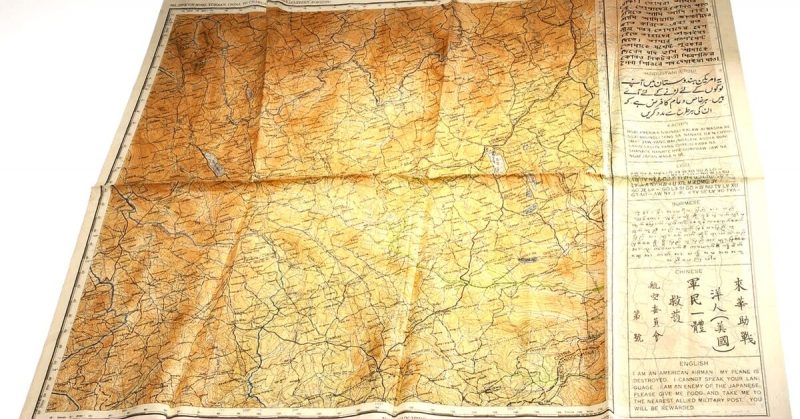Any bride-to-be who talks about having found a very special wedding dress must forgive her listeners when they visualize flowing lines of beautiful satin, pretty lace, charming frills and exquisite beading. For Hester Cox of North Yorkshire, England, her ‘something special’ was very lovely, but most unusual, in that her wedding dress was created from the vintage silk on which WWII escape maps were printed!
Hester, an artist, whose work is in printmaking, has often used maps in her work, and always found them to be really fascinating. She was attending a local Art Fair when she met up with Sara Murray, the owner of Home Front Vintage, who just happens also to be fascinated by these war-time, vintage, silk maps. Sara had come across a number of WWII and Cold War maps in an old junk shop, and was determined to do “something” with them. She came up with the idea of making them into things that would be beautiful, as well as useful. She could make such items as cushion covers, lampshades and note book covers or even artistically frame some of the undamaged maps. She was determined to use them for making beautiful items that people would want to take into their homes.
Sara and Hester, finding they both enjoyed these old maps, became inspired with the idea of making a wedding dress for Hester, entirely out of these silk maps. With the collaboration of Hester, Sara set to work on the creation of this very special dress. Heather chose the maps which for her were most important, or which meant something special to her, and Sara worked on the design of the dress. She was able to change a lovely 1940s dress-style pattern, fancied by Hester, into one suitable for a wedding dress. She managed to alter the neckline, and she also decided to make the skirt somewhat fuller.
The whole dress was lined with turquoise silk, which matched the original fabric that had been used for the maps. Hester had her lovely, custom-made wedding dress, fashioned from WWII, vintage silk Escape and Evade maps – a very unusual wedding dress.
Silk maps were used extensively by servicemen during WWII, as well as during the Cold War. It was Clayton Hutton, a British Army Officer from MI9 who came up with the idea. He then set about bringing it to fruition. He first approached the map-making company, persuading them, on the grounds of supporting the war effort, to waive the copyright for those maps used for escape. In this way, they enabled any servicemen shot down or captured behind enemy lines to escape to safety.
Since silk did not rustle as paper did, the maps could be easily and quickly folded up very small and were easy to hide. Hutton found it to be the ideal material to use. He had the maps printed, and they were issued to Pilots and Special Forces personnel. The silk maps would frequently be hidden in a box of cigarettes, they were put inside the heel of a boot, they could be sewn into a seam, a collar or a cap, in fact there was no end to where one could hide such a small, quiet, useful item which would be very difficult to discover in the case of being searched or ‘frisked down.’ Further, they were surprisingly strong, being able to withstand quite heavy wear and tear and would not be damaged by being doused in water.
These silk maps were used throughout WWII, and for quite some time afterward, for they were extensively used during the Cold War. Escape maps were at times – and not without great difficulties – smuggled into prison-of-war camps, giving the inmates a better chance of finding their way home in the event that they managed to escape their prison. Most of the American silk maps were in actual fact not printed on silk material, but rather on materials of rayon acetate. They, however, also had a silky texture, so retained the name.
Besides the stated purpose of these maps – Escape and Evade – there are many reports of them being used for other emergency purposes. They were utilized as a makeshift sling, a bandage, for filtering water and even for patching clothing – and today we have the story of them being used for a special wedding dress.
When Hester walked down the aisle on her wedding day, she was assured that the collaboration between herself and Sara had resulted in a superbly special wedding dress, one which she absolutely loved. It was interesting that some people at the wedding had no idea that it was made from real, vintage, silk maps, so she was teased about possibly using the maps for ‘escaping & evading’ her new husband! Most important of all perhaps – her husband roundly approved of this special and unusual wedding dress, making Hester doubly determined to wear it again.
